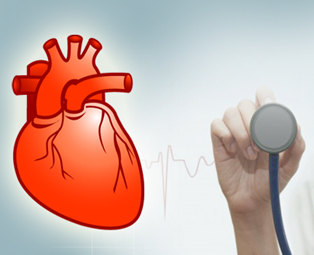Cardiology Clinic
The human heart is an important organ which is responsible for pumping blood throughout the body via circulatory system, supplying oxygen to the tissues, and removing carbon dioxide and other wastes. The tissues of the human body require a constant supply of nutrients to keep on working, if the heart is unable to supply blood to the organs and tissues, they will die. A human heart is roughly the size of a large fist and weighs between about ten to twelve ounces in men and eight to ten ounces in women.

 Functions of the Heart
Functions of the Heart
Arterial blood flows from the heart to each part of the human body for providing oxygen and nutrients. The venous blood returns straight from the body to the heart. The blood then travels through the lungs in order to exchange carbon dioxide for new oxygen. The heart is a pump, mainly moves the blood. The veins and arteries are the pipes through which the blood flows. The lungs offer a place to exchange carbon dioxide for oxygen.
Common Heart Diseases
Heart diseases include the conditions affecting the structures or functions of the heart, such as:
Abnormal Heart Rhythms or Arrythmia- Human heart is an amazing organ which beats about 60 to 100 times every minute. Sometimes, the heart gets out of rhythm. An irregular heartbeat is called an arrhythmia. An arrhythmia can produce an uneven heartbeat, or very slow or fast beat. In this condition, your doctor will request a
Holter test.
Coronary Artery Disease (CAD) or Ischemia- It is hardening and blockage of the arteries, which provide the heart vital oxygen and nutrients. If you have blockage in the arteries of your heart, the doctor may recommend you a
treadmill stress test or
echocardiography.
Valvular abnormalities- Heart valves sit at the exit of each four heart chambers maintain one-way blood flow through the heart. Improper functioning of the heart valves may cause symptoms from shortness of breath to dizziness and passing out. There are four valves in the heart:
- Pulmonary valve: It is located between the right ventricle and the pulmonary artery.
- Tricuspid Valve: It is located between the right atrium and the right ventricle
- Aortic Valve- Located Between the left ventricle and the aorta
- Mitral Valve- Located between the left atrium and the left ventricle
Your doctor may recommend an
echocardiogram to evaluate valvular abnormalities.
Noninvasive Blood Pressure (NIBP)
What is Blood Pressure?
Blood pressure refers to the force of blood pushing against the walls of your arteries. When your heart beats, it contracts and pushes the blood through the arteries to the rest of your body, perfusing all organs. The force generates pressure on the arteries and is known as systolic blood pressure. A normal systolic blood pressure should be less than 120 millimeters of mercury.


‘Diastolic blood pressure’ is the term used to value the bottom number of a blood pressure. This signifies the pressure in the arteries when your heart rests after contracting. A normal diastolic blood pressure is less than 80 millimeters of mercury.
Measuring Blood Pressure
Arterial pressure can be measured invasively or non-invasively. However, the former is restricted to a hospital setting.
Noninvasive Measurement
The noninvasive auscultatory and oscillometric measurements are easier and quicker than invasive measurement, require less expertise in fitting, have no complications, and less painful and unpleasant for the patients. It includes the application of a pressure cuff and can be performed manually or automatically.
Method
Blood pressure is usually determined by analyzing oscillation of BP cuff pressure caused by the arterial pulses.
In order to block arterial blood flow, the BP cuff is inflated and then it starts to deflate. In doing so, arterial pulses generate a pressure wave in the cuff. These waves are the source data for oscillometric noninvasive blood pressure algorithm.
Since the cuff is the sensor, it’s important that the correct size is picked by the clinician. Moreover, the cuff needs to be wrapped around the arm properly.
There are commonly two types of methods for measuring blood pressure:
- An electronic blood pressure monitor generally has an internal pump which inflates the cuff. The inflation of the cuff is monitored electronically from pressure and pulse. The machine gives an indication of blood pressure.
- A mechanical device called sphygmomanometer is also used for measuring blood pressure.

 9818646277
9818646277




 Functions of the Heart
Functions of the Heart
 ‘Diastolic blood pressure’ is the term used to value the bottom number of a blood pressure. This signifies the pressure in the arteries when your heart rests after contracting. A normal diastolic blood pressure is less than 80 millimeters of mercury.
‘Diastolic blood pressure’ is the term used to value the bottom number of a blood pressure. This signifies the pressure in the arteries when your heart rests after contracting. A normal diastolic blood pressure is less than 80 millimeters of mercury.
Follow Us On: